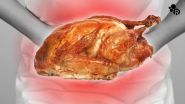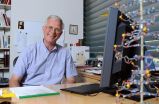For important tumor-suppressing protein, context is key
Berkeley Lab scientists learn new insights into how p53 binds to the human genome
2014-11-24
(Press-News.org) Scientists from the US Department of Energy's Lawrence Berkeley National Laboratory (Berkeley Lab) have learned new details about how an important tumor-suppressing protein, called p53, binds to the human genome. As with many things in life, they found that context makes a big difference.
The researchers mapped the places where p53 binds to the genome in a human cancer cell line. They compared this map to a previously obtained map of p53 binding sites in a normal human cell line. These binding patterns indicate how the protein mobilizes a network of genes that quell tumor growth.
They found that p53 occupies various types of DNA sequences, among them are sequences that occur in many copies and at multiple places in the genome. These sequences, called repeats, make up about half of our genome, but their function is much less understood than the non-repeated parts of the genome that code for genes.
It's been known for some time that p53 binds to repeats, but the Berkeley Lab scientists discovered something new: The protein is much more enriched at repeats in cancer cells than in normal cells. The binding patterns in these cell lines are very different, despite the same experimental conditions. This is evidence, they conclude, that in response to the same stress signal, p53 binds to the human genome in a way that is selective and dependent on cell context--an idea that has been an open question for years.
The research is published online Nov. 21 in the journal PLOS ONE.
"It is well established that p53 regulates specific sets of genes, depending on the cell type and the DNA damage type. But how that specificity is achieved, and whether p53 binds to the genome in a selective manner, has been a matter of debate. We show that p53 binding is indeed selective and dependent on cell context," says Krassimira Botcheva of Berkeley Lab's Life Sciences Division. She conducted the research with Sean McCorkle of Brookhaven National Laboratory.
What exactly does cell context mean in this case? The DNA that makes up the genome is organized into chromatin, which is further packed into chromosomes. Different cell types differ by their chromatin state. Cancer can change chromatin in a way that doesn't affect DNA sequences, a type of change that is called epigenetic. The new research indicates that epigenetic changes to chromatin may have a big impact on how p53 does its job.
"To understand p53 tumor suppression functions that depend on DNA binding, we have to examine these functions in the context of the dynamic, cancer-associated epigenetic changes," says Botcheva.
Their finding is the latest insight into p53, one of the most studied human proteins. For the past 35 years, scientists have explored how the protein fights cancer. After DNA damage, p53 can initiate cell cycle arrest to allow time for DNA repair. The protein can promote senescence, which stops a cell from proliferating. It can also trigger cell death if the DNA damage is severe.
Much of this research has focused on how p53 binds to the non-repeated part of the genome, where the genes are located. This latest research suggests that repeats deserve a lot of attention too.
"Our research indicates that p53 binding at repeats could be essential for maintaining the genomic stability," says Botcheva. "Repeats could have a significant impact on the way the entire p53 network is mobilized to ensure tumor suppression."
INFORMATION:
The research was supported by the U.S. Department of Energy's Office of Science.
ELSE PRESS RELEASES FROM THIS DATE:
2014-11-24
Researchers at UC San Francisco have identified patterns of genetic activity that can be used to diagnose endometriosis and its severity, a finding that may offer millions of women an alternative to surgery through a simple noninvasive procedure.
The study is online in the journal Endocrinology.
"This promising molecular diagnostic approach would not have been possible without advances in genomics and bioinformatics," said senior author Linda Giudice, MD, PhD, distinguished professor and chair of obstetrics, gynecology and reproductive sciences at UCSF.
"Importantly, ...
2014-11-24
A protein that stimulates the brain to awaken from sleep may be a target for preventing Alzheimer's disease, a study by researchers at Washington University School of Medicine in St. Louis suggests.
In recent years, scientists at Washington University have established links between sleep problems and Alzheimer's. For example, they have shown in people and in mice that sleep loss contributes to the growth of brain plaques characteristic of Alzheimer's, and increases the risk of dementia.
The new research, in mice, demonstrates that eliminating that protein - called orexin ...
2014-11-24
WASHINGTON, Nov. 24, 2014 -- The season of giving is often also the season of over-indulging at the dinner table. As Thanksgiving approaches, Reactions takes a look down at our stomachs to find out what happens when you overeat. Put on your "eating pants" and enjoy the video here:
Subscribe to the series at Reactions YouTube, and follow us on Twitter @ACSreactions to be the first to see our latest videos.
INFORMATION:The American Chemical Society is a nonprofit organization chartered by the U.S. Congress. With more than 161,000 members, ACS is the world's largest scientific ...
2014-11-24
How does glass transition from a liquid to its familiar solid state? How does this common material transport heat and sound? And what microscopic changes occur when a glass gains rigidity as it cools?
A team of researchers at NYU's Center for Soft Matter Research offers a theoretical explanation for these processes in Proceedings of the National Academy of Sciences.
Our understanding of glasses as they change state is relatively limited. This is because, unlike other materials such as metals, their constituent particles--which can be as small as a billionth of a meter ...
2014-11-24
People who see their group as more homogenous - for instance, the more one thinks Americans are similar to each other - are less likely to be influenced by external terrorist threat alerts, according to research from NYU's Steinhardt School of Culture, Education, and Human Development.
"Among people who viewed their group to be homogeneous, external threat did not translate to higher perceived threat, and they did not influence beliefs about the legitimacy of the U.S. military intervention in Iraq," said study author Rezarta Bilali, assistant professor of psychology and ...
2014-11-24
ANN ARBOR--The medical community may be inadvertently creating a new generation of illegal, recreational drug users by prescribing anti-anxiety or sleep medications to teenagers, say University of Michigan researchers.
Teens prescribed anxiety or sleep medications are up to 12 times more likely to abuse those drugs than those who had never had a prescription, either by using someone else's prescription pills or to get high or experiment, according to a study from the U-M School of Nursing.
Nearly 9 percent of the 2,745 adolescent study participants had received ...
2014-11-24
A team of scientists from Arizona State University's Biodesign Institute and IBM's T.J. Watson Research Center have developed a prototype DNA reader that could make whole genome profiling an everyday practice in medicine.
"Our goal is to put cheap, simple and powerful DNA and protein diagnostic devices into every single doctor's office," said Stuart Lindsay, an ASU physics professor and director of Biodesign's Center for Single Molecule Biophysics. Such technology could help usher in the age of personalized medicine, where information from an individual's complete DNA ...
2014-11-24
SAN FRANCISCO (November 24, 2014) --A team of scientists, including researchers from the California Academy of Sciences, has reconstructed a detailed "tree of life" for turtles. The specifics of how turtles are related--to one another, to other reptiles, and even to dinosaurs--have been hotly debated for decades. Next generation sequencing technologies in Academy labs have generated unprecedented amounts of genetic information for a thrilling new look at turtles' evolutionary history. These high-tech lab methods revolutionize the way scientists explore species origins and ...
2014-11-24
Members of the public in sub-Saharan Africa who are carriers of the hereditary disease sickle cell disease must be educated aggressively through public health campaigns to raise awareness of the risks of parenting offspring with the disease if their partner is also a carrier, according to research published in the International Journal of Medical Engineering and Informatics.
There are many physical and emotional public health components of sickle cell disease, explains William Ebomoyi of the Department of Health Studies College of Health Sciences, Chicago State University, ...
2014-11-24
A collaboration between NEC Electronics Samsung and several academic centres in China and Iran, is investigating how software-defined cellular networking might be used to give smart phone users the next generation of super-superfast broadband, 5G. They provide details in the International Journal of Communication Networks and Distributed Systems.
Currently, the fourth generation of mobile phone connection technology, 4G, in as far as it has been adopted provides broadband-type connectivity for enabled devices such as smart phones, tablet computers, laptops and other gadgets ...
LAST 30 PRESS RELEASES:
[Press-News.org] For important tumor-suppressing protein, context is key
Berkeley Lab scientists learn new insights into how p53 binds to the human genome



